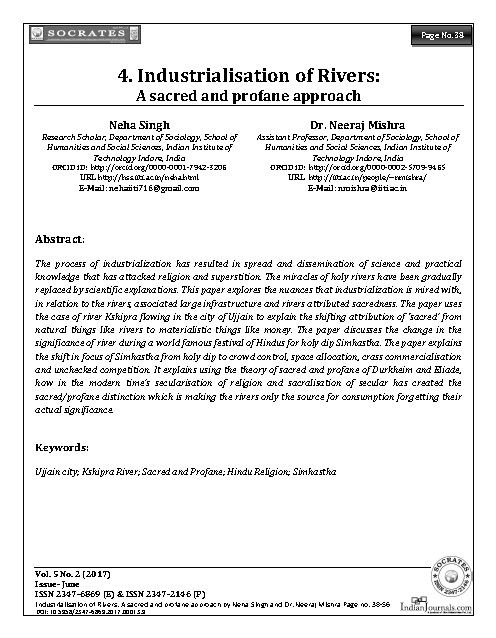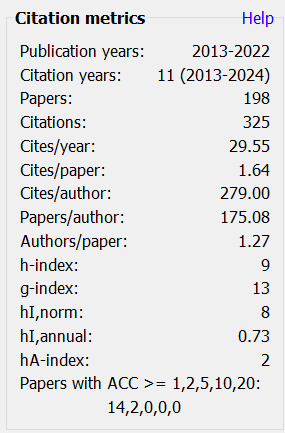Industrialisation of Rivers
A sacred and profane approach
DOI:
https://doi.org/10.5958/2347-6869.2017.00013.9Keywords:
Ujjain city, Kshipra River, Sacred and Profane, Hindu Religion, SimhasthaAbstract
The process of industrialization has resulted in spread and dissemination of science and practical knowledge that has attacked religion and superstition. The miracles of holy rivers have been gradually replaced by scientific explanations. This paper explores the nuances that industrialization is mired with, in relation to the rivers, associated large infrastructure and rivers attributed sacredness. The paper uses the case of river Kshipra flowing in the city of Ujjain to explain the shifting attribution of ‘sacred’ from natural things like rivers to materialistic things like money. The paper discusses the change in the significance of river during a world famous festival of Hindus for holy dip Simhastha. The paper explains the shift in focus of Simhastha from holy dip to crowd control, space allocation, crass commercialisation and unchecked competition. It explains using the theory of sacred and profane of Durkheim and Eliade, how in the modern time's secularisation of religion and sacralisation of secular has created the sacred/profane distinction which is making the rivers only the source for consumption forgetting their actual significance.
Article DOI : 10.5958/2347-6869.2017.00013.9
Downloads
Metrics
References
Alley, K.D. (2012). The Paradigm Shift in India’s River Policies: From Sacred to transferable Waters. In Johnston, R.B. Klaver, I.J. Castillo-Ramos, A., Strang, M., Neles.
Adams, P. (2003). Water in Religion. Water Policy International Limited. From: http://www.africanwater.org/religion.html.
Appadurai, A. (1988). The Social Life of Things: Commodities in Cultural Perspective. Cambridge University Press, Ch- 1.
Bhatt, K. ( 2015). The Mammoth, the multi-faith Kumbh Mela: A place of practical plurality and Colossal Chaos. Oxford Centre for Hindu Studies. University of Oxford. United Kingdom. Available from: http://www.ochs.org.uk/lectures/mammoth-multi-faith-kumbh-mela-place-practical-plurality-amid-colossal-chaos
Belk, W. R., Wallendorf, M., Sherry, F. J. (1989). The sacred and the profane in consumer behaviour: Theodicy on the Odyssey. Oxford Journal, Journal of Consumer Research. Vol 16. From: http://jcr.oxfordjournals.org.
Brereton, J. P. (1987). “ Sacred Space,” in Encyclopedia of Religion, Vol. 12, ed. Mircea Eliade, New York: Collier- Mac Millan, p. 526-535.
Berman, M. (1984). The Re-enchantment of The World, Toronto, Canada: Bantam.
Brandon, S.G.F. (1965). History, time and deity. Manchester: University Press.
Bossard, J.H.S., Eleanor, S.B. (1950). Ritual in Family Living. A contemporary study Philadelphia: University of Pennsylvania Press.
Bharadwaj, S. (1973). Hindu Places of Pilgrimage in India. Thomson Press. India Limited: Delhi. University of California Press Berkeley, Los Angeles-London.
Berman, M. (1984). The Reenchantment of the World, Toronto, Canada: Bantum.
Bhabha, K.H. (1994). The Location of Culture. Routledge, New York.
Capra, F. (1975). The Tao of Physics, Toronto, Canada: Bantam.
Coser, L. (2003), Masters of Sociological Thought.
Colopy, C. (2012). Dirty Sacred Rivers Confronting South Asia’s Water Crisis. Oxford University Press, p.3.
Demerath, N.J. III. (1974). A tottering Transcendence: Civil vs. Cultic Aspects of the Sacred. Indianapolis, IN: Bobbs-Merrill.
Durkheim, E. [1912] (1965). The Elementary forms of religious life. Trans. By Joseph Ward Swain. New York: The Free Press.
Eliade, M. (1959). The sacred and the profane: The nature of religion. Trans. By Willard R. Trask. New York: Harcourt, Brace and Company.
Eck, D. (1981). India’s Tirthas: ‘Crossings’ in sacred geography. History of Religions Vol 20. No.4, May, pp.324-344.
Fields, K.E.(1995). The Elementary Forms of Religious Life. The Free Press A Division of Simon & Schuster Inc.
Fallon, J.M., Jaiswal, N.K. (2012). Sacred space, Sacred water: Exploring the Role of Water in India’s Sacred places. From: https://journal.lib.uoguelph.ca/index.php/rasaala/article/view/2191/2678.
Fasching, J. D. (2012). The Sacred, the secular and the Holy: The Significance of Jacques Ellul’s Post- Christian Theology for Global Ethics.
GoMP. (2016). Simhastha. Government of Madhya Pradesh. Available from: http://www.simhasthujjain.in/the-eternal-river/
Giri, K. Y., (2014). Conservation plan for Kshipra River. Madhya Pradesh Water Resource Development Bhopal. Available from: https://www.slideshare.net/ravindrapastor/kshipra-river-convergence-plan
Geist, C. D. (1978). “ Historic Sites and Monuments as Icons,” Icons of America, eds. Ray B. Browne and Marshall Fishwick, Bowling Green, OH: Bowling Green University Popular Press, p. 57-66.
Gladstone, D. (2005). From Pilgrimage to package Tour Travel and Tourism in the Third World. Oxon: Routledge.
Inkeles, A. (1983). Exploring Individual Modernity. New York: Columbia University Press.
Kumar, S., Shah, L. (2004). Digital Preservation of Manuscripts: Case Study. Inflibnet Centre, Ahmedabad. From:http://ir.inflibnet.ac.in/bitstream/1944/419/1/04Planner_5.pdf.
K. Satish Kumar, H.L. Tiwari, R.V. Galkate, Water Availability Assessment In Shipra River, in International Journal of Research in Engineering and Technology, [Online] 11(4) (2015): 127 [cited 31 March 2016], Available from file:///F:/IJRET20150411024.pdf
Lukes, S. (1985). Emile Durkheim: His Life and Work.
Levi, R. Mishori, D., (2015). Water, the Sacred and the Common of Rajasthan. A Review of Anupam Mishra’s Philosophy of Water Transcience Vol.6, Issue 2, pp.1-3. From https://www2.hu-berlin.de/ranscience/Vol6_No2_1_25.pdf.
Menon, M., 2016. Dry river fails to dampen Kumbh Mela spirit in Ujjain. Reuters. http://blogs.reuters.com/india/2016/05/20/dry-river-fails-to-dampen-kumbh-mela-spirit-in-ujjain/
McKinnon, M. A. (2005). Opium as Dialectics of Religion: Metaphor, Expression, and Protest. University of Aberdeen. Published in Critical Sociology, Vol 31, no. 1/2, pp. 15-38. Available from:http://aura.abdn.ac.uk/bitstream/handle/2164/3074/marx_religion_and_opium_final_author_version.pdf;jsessionid=9A20ECE45D2CBC14C636C84E2138B31E?sequence=1
National Water Mission, (2011). Support for the National Action Plan on Climate Change Support to the National Water Mission. Government of India.
Olson, E. (2000). Marx vs. Durkheim: Religion. From: http://web.pdx.edu/~tothm/theory/Marx%20and%20Durkheim%20on%20Religion.doc.
Orru, M., Wang, A. (1992). Durkheim, Religion, and Buddhism. Wiley Blackwell. Journal for the Scientific Study of Religion. Vol. 31. No.1, pp. 47-61. From: traub300.ulb.ac.bc/2012-2013/groupe163/archeive/files/4c285ta3941f47799751296836d76f5f.pdf.
Purohit, M. (2016). “At Simhastha government fishes in Kshipra’s troubled water.” India Water Portal. Available From: http://www.indiawaterportal.org/articles/simhastha-government-fishes-kshipras-troubled-waters
Pickering, W.S.F.(1984). Durkheim’s sociology of religion. London: Routledge & Kegan.
PTI, 2016. Ujjain: As Kumbh draws to a close, devotees throng Kshipra for ‘shahi snan’. Indian Express. http://indianexpress.com/article/india/india-news-india/ujjain-simhastha-humbh-mela-ends-kshipra-river-2812330/
Roberts, K. A. (1984). Religion in Sociological Perspective. Homewood. IL:Dorsey.
Roy, A. (1999). The Greater Common Good. In the Cost of Living. London, Flamingo.
Rook, D. W. (1984). “Ritual Behaviour and Consumer Symbolism,” in Advances in Consumer Research, Vol II, ed. Thomas C. Kennear, Provo, UT: Association for Consumer Research, p.279-284.
Shiva, V. ( 2002). Water Wars: Privatization, pollution, and profit. Cambridge; South End Press.
Shiner, L. E. (1972). “ Sacred Space, Profane Space. Human Space.” Journal of the Academy of Religion, 40 (4), p. 425-436.
Tvedt, T. (2015). Water and Society: Changing Perception of Societal and Historical Development. I.B. Tauris and Company.
UNESCO. (2006). Pure, Good, Divine: the Sacredness of Water in History. From: www.unesco.org/new/fileadmin/MULTIMEDIA/FIELD/Venice/pdf/special_events/bozza_scheda_DOW_7_1.0.pdf.
Warner, W.L. (1959). The Living and the Dead: A Study of the symbolic Life of American. New Heaven. CT: Yale University Press.

Downloads
Published
How to Cite
Issue
Section
License
Copyright (c) 2017 Singh Neha, Mishra Neeraj, Dr.

This work is licensed under a Creative Commons Attribution-NonCommercial 4.0 International License.
Revised Copyright/CC license that applies to all the articles published after 05-02-2017
Attribution-NonCommercial 4.0 International (CC BY-NC 4.0)

Copyright/CC license that applies to all the articles published before 05-02-2017
Attribution-Non Commercial-No Derivatives 4.0 International (CC BY-NC-ND 4.0)

Author(s) will retain all the right except commercial and re-publishing rights. In the case of re-publishing, they will have to obtain written permission from the journal. Additional licensing agreements (Creative Commons licenses) grants rights to readers to copy, distribute, display and perform the work as long as you give the original author(s) credit, they can not use the works for commercial purposes and are not allowed to alter, transform, or build upon the work. For any reuse or distribution, readers and users must make clear to others the license terms of this work. Any of these conditions can be waived if you get permission from the copyright holders. Nothing in this license impairs or restricts the authors’ rights. To view a copy of this license, visit http://creativecommons.org/licenses/by-nc-nd/4.0/ or send a letter to Creative Commons, 171 Second Street, Suite 300, San Francisco, California, 94105, USA.
Research Papers published in SOCRATES are licensed under an Attribution-NonCommercial-NoDerivatives 4.0 International (CC BY-NC-ND 4.0)
















